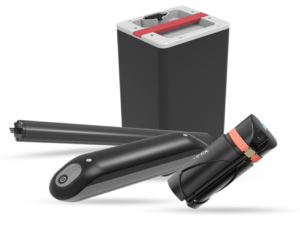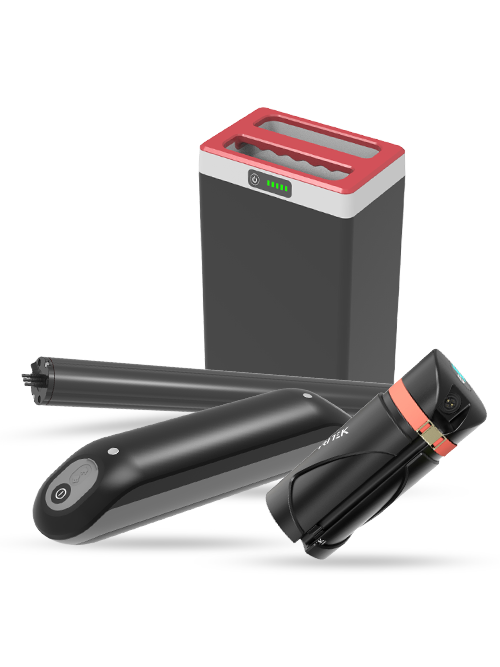With the development of the global new energy industry, lithium battery has become a high-demand industry, and power lithium battery has become a concentrated area of demand growth of the lithium battery industry.
So do you fully understand lithium-ion cell technology knowledge? This is a comprehensive guide to this summary from Tritek’s R&D Director.
We also prepared Ebike Glossary Of Terms for you to quickly search.
Basic knowledge of cell
Battery development history
Battery is a device that converts chemical energy into electrical energy, providing direct electrical energy to the outside through chemical reactions in the battery.
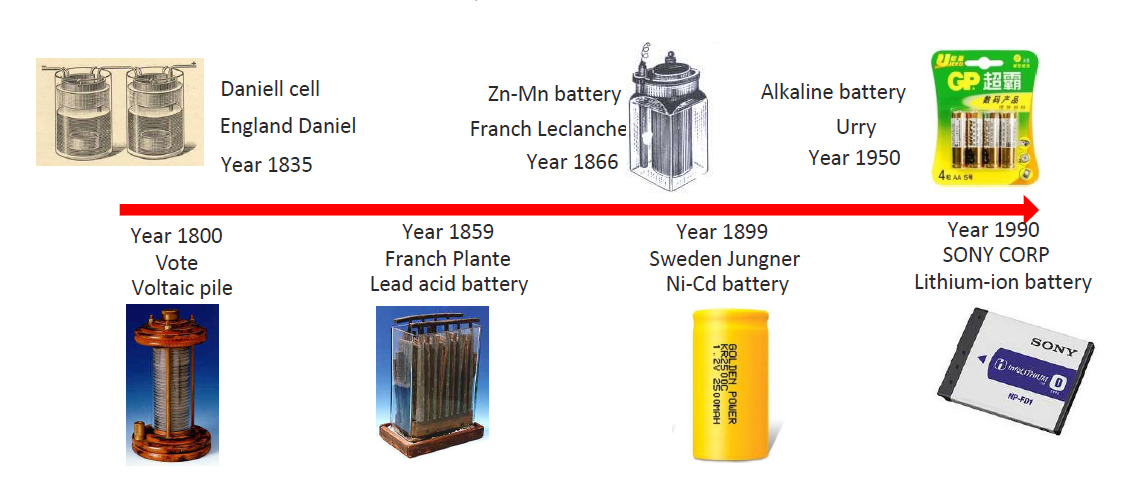
Battery Category
Batteries are mainly divided into three types: chemical battery, physical battery and biobattery. Here is a mind map of battery classification.

The development direction of power battery

Ni-Cd Battery→Ni-Zn Battery→Lead-Acid Battery→Ni-MH Battery→Lithium-ion battery→Fuel Battery
Ni-Cd Battery: Serious pollution, has been basically eliminated.
Ni-Zn Battery: Short life, performance is not suitable for vehicle batteries.
Lead-Acid Battery: Firstly used as a vehicle battery, is still in use now, low cost, but with low specific energy, high self-discharge rate, low cycle life, not environmental-friendly.
Ni-MH Battery: Most commonly used in HEV(hybrid electric vehicle), which performs better but costs more and contains the polluting metal nickel.
Lithium-ion battery: Industrialization hot spot of automotive battery at the moment, good performance, environmental.
Triteks’ LEV products such as E-bike battery, Custom E-bike battery, E-motorcycle battery, Cargo-bike battery all apply lithium-ion battery.
Fuel Battery: Not yet industrialized, good performance, environmentally-friendly, but the price is high.
Lithium battery – Development history
With carbon as the negative electrode and lithium compound as the positive electrode; In the process of charging and discharging, lithium ions travel back and forth between the positive and negative electrodes, which is how lithium-ion batteries get their name.

Lithium battery – How it works
In the process of charge and discharge of lithium-ion battery, lithium-ion is in a state of motion from positive to negative to positive. It’s like a rocking chair, with lithium ions moving back and forth between the two ends of the battery. This electrochemical energy storage system is known as the ”rocking chair battery”.
Lithium battery – How it works – Charging process&Discharging process
1.6.1 Lithium ions are embedded in the layered structure of the positive electrode material before charging.
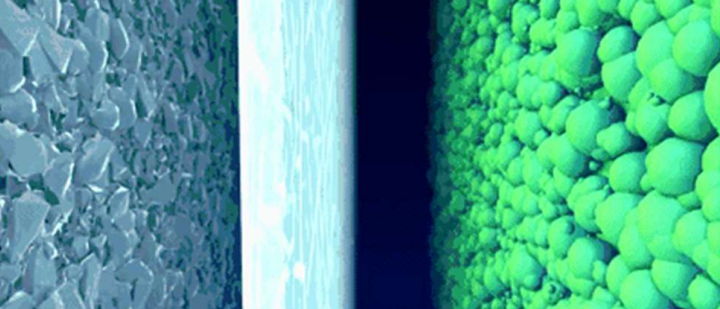
1.6.2 After starting charging, the positive electrode material loses electrons and lithium ions escape from the positive electrode material. 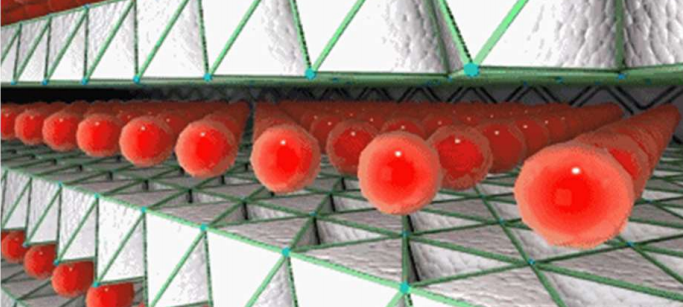
1.6.3 Lithium ions arrive at the negative graphite material through electrolyte and separator. 
1.6.4 Lithium ions are embedded in the graphite layer, while electrons pass through the outer circuit to the negative electrode, forming a relatively stable lithium-embedded graphite. 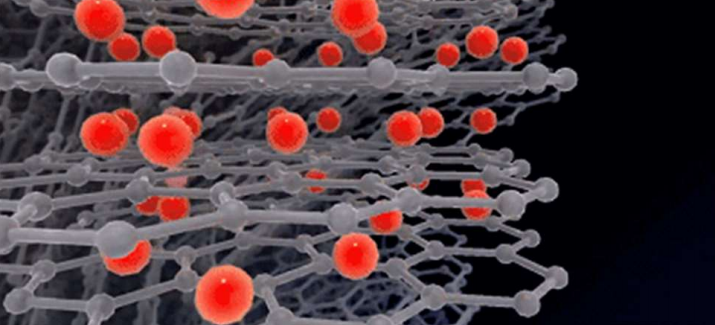
1.6.5 During continued charging, the positive electrode material continues to lose electrons and lithium ions continue to be unembedded until the charging is completed.
1.6.6 Electrons leave from the negative electrode material and flow to the positive electrode through the outer circuit. Lithium ions that have lost electrons also escape from the graphite layers.
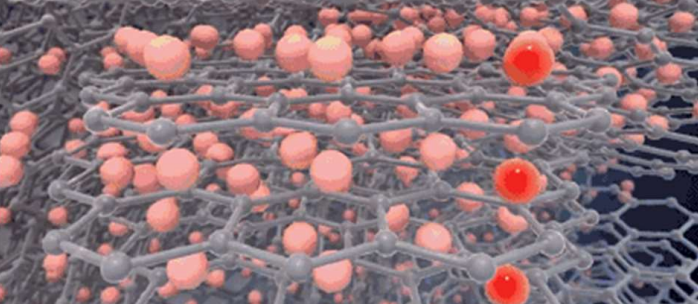
1.6.7 Lithium ions removed from the negative electrode return to the positive electrode material through the electrolyte and separator, and combine with the electrons arriving at the positive electrode through the external circuit to form a relatively stable lithium-embedded positive electrode material.
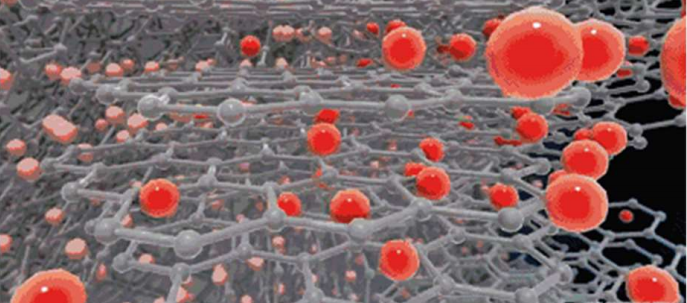
Lithium Battery – Structural composition
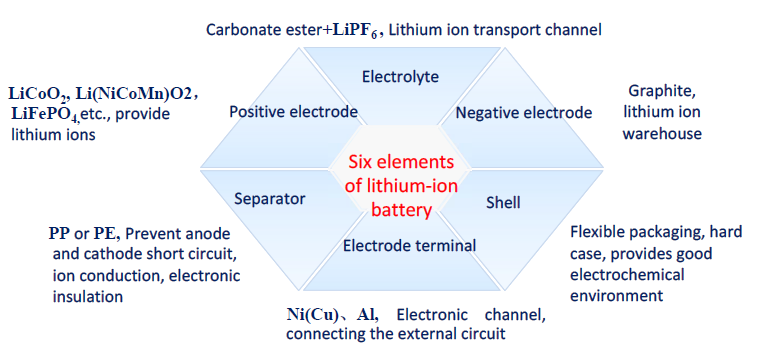
Lithium Battery – Positive electrode material
| Positive electrode material | LiCoO2 | Li(NiCoMn)O2 | LiMn2O4 | LiFePO4 |
| Crystal Structure | Stratiform | Stratiform | Spinel | Olivine |
| Theoretical specific capacity/mAh·g-1 | 274 | 278 | 148 | 170 |
| Actual specific capacity/mAh·g-1 | 140-155 | 130-220 | 90-120 | 130-150 |
| The range of operating voltage/V | 3.0-4.3 | 3.0-4.35 | 3.5-4.3 | 2.5-3.8 |
| Platform voltage/V | 3.6-3.7 | 3.6-3.7 | 3.7-3.8 | 3.2-3.3 |
| Material processing property | Good | Higher | Medium | Bad |
| Cycle life/time | >500 | >500 | >500 | >2000 |
| Safety performance | Bad | Better | Good | Excellent |
| Price | High | Higher | Low | Medium |
| Toxicity/Environmental Conservation | General | General | Bad | Good |
| Toxicity/Environmental conservation | Toxic cobalt | Toxic cobalt | Non-toxic | Non-toxic |
Lithium Battery – Classification
Lithium batteries can be classified according to shape, shell and craft.

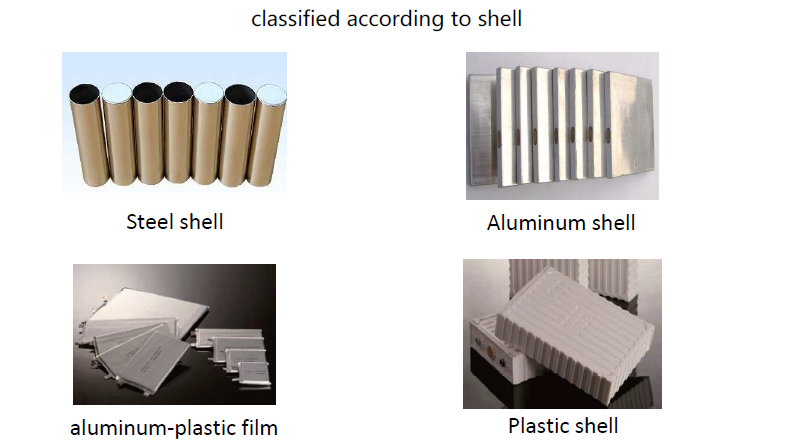

Tritek chooses coiled-type cylindrical steel shell structures, mainly 18650 and 21700 batteries.
Lithium Battery – Performance parameter
- Battery Capacity
The discharge capacity (Ah) of the battery at room temperature at 1I1(A) current to reach the termination voltage.
Formula: C=It, i.e. battery capacity (Ah) = current (A)x discharge time (h).
Battery capacity refers to the amount of power a battery can get or the amount of power it can store.
The capacity is determined by the active substance of the electrode and is mainly affected by the discharge rate and temperature (so strictly speaking, the battery capacity should specify the charging and discharging conditions).
Click to learn How To Choose the Right Battery Capacity for Improved E-Bike Performance
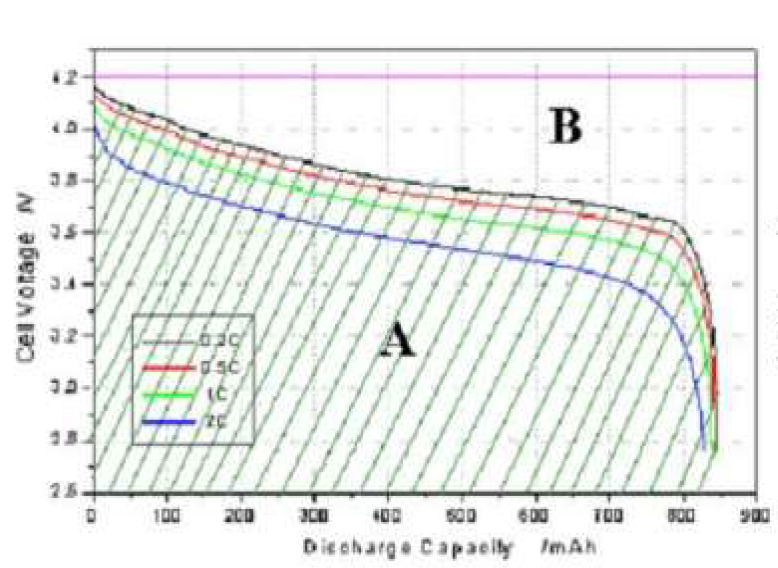
The relationship between capacity and discharge temperature:

- Voltage
It refers to the potential difference(PD) between the positive and negative electrodes of the battery (the voltage is affected by the battery power, temperature and other conditions).
Lear more about —> How Battery Voltage Affects E-Bike’s Performance
How to Choose the Right Voltage for Electric Motorcycle Batteries
- Open-circuit voltage(OCV)
The voltage of the battery when it is not connected to an external circuit or external load. The open circuit voltage is related to the remaining energy of the battery, and the power display is based on this principle.
- Closed-circuit voltage(CCV)
It refers to the potential difference(PD) between the positive and negative electrodes of the battery in the working state, i.e., when there is current flowing through the circuit.
- Stage of Charge(SOC)
Is the remaining battery power ratio, equal to the remaining battery power/total battery power, SOC=0% indicates that the battery is completely drained, and SOC=100% indicates that the battery is fully charged.
SOC is calculated by Battery Management System (BMS).
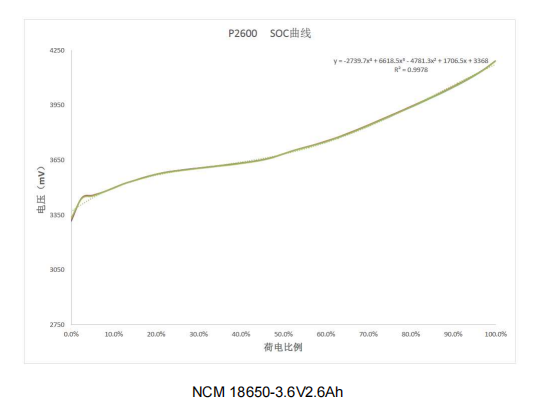
- Depth of Discharge(DOD)
It refers to the discharge depth of the battery, i.e., the percentage of the battery discharge to the rated battery capacity, contrary to SOC, DOD=100% indicates that the battery is out of power, and DOD=0% indicates that the battery is fully charged. The relationship between DOD and SOC is as follows: DOD+SOC = 1.
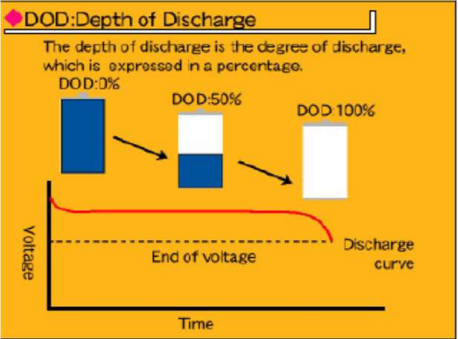
- Internal Resistant
Refers to the resistance of current flowing through the battery when the battery is working. Generally divided into AC(alternating current) internal resistance and DC(direct current) internal resistance. Normally, a battery with a small internal resistance has a strong discharge capacity, while a battery with a large internal resistance has a weak discharge capacity. Large internal resistance of the battery will generate a large amount of joule heat, which will cause the internal temperature of the battery to rise, resulting in the reduction of the working voltage of the battery discharge, the discharge time shortened, and the battery performance and service life are seriously affected.
- Temperature rise
Heat generated when an electric current passes through a conductor Q=I2Rt
|
Internal resistance of cell |
Ohmic resistance |
The active substance of the positive and negative electrodes, the current collector, and the electronic resistance of the lead |
Obey Ohm’s law, is fixed, make the voltage drop is proportional to the current |
|
Ionic resistance inside an electrolyte, separator, or electrode |
|||
|
Contact resistance between the active substance of the positive and negative electrodes and the current collector |
|||
|
Polarization resistance |
Active polarization resistance – caused by an electrochemical reaction on the electrode surface |
The polarization resistance increases linearly with the logarithm of current density (discharge rate) |
|
|
Concentration difference polarization resistance – the difference in the concentration of reactants and products on the electrode surface and in the volume phase, as a result of material transfer. |

- Discharge platform time
Discharge platform time refers to the discharge time to a certain voltage when the battery is fully charged. Discharge platform is a feature of the battery discharge curve. The unit is minute.
- Charge constant current ratio
The ratio of constant current charge to the total charge of constant current and constant voltage. The higher the constant current ratio, the better the battery performance. The unit of constant current ratio is the percentage (%).
- Cycle life
Battery cycle life refers to the number of charging and discharging times experienced by a battery under a certain charging and discharging system,when the battery capacity drops to a certain specified value.
Understand Lithium Battery Lifespan: How Many Charging Cycles Can You Expect?
- Charge-discharge rate
Charge and discharge rate refers to the current required by the battery to discharge the rated capacity within the specified time. 1C is equal to the rated capacity of the battery and is usually represented by the letter C.
- Self-Discharge rate
Self-discharge rate, also known as charge retention, refers to the ratio of the reduced capacity to the initial capacity when the battery is fully charged and stored for a certain time under certain conditions in an open circuit state. The unit of self-discharge rate is the percentage (%).
The smaller the self-discharge, the better, and the larger the charge retention, the better. Batteries with large self-discharge tend to show a rapid voltage drop after storage for a while. It is mainly affected by the manufacturing craft, materials, storage conditions and other factors.
- Charging efficiency
A measure of the extent to which a battery can store chemical energy by converting the electrical energy consumed during charging. It is mainly affected by battery craft, formula, ambient temperature, charging rate and other factors. In general, the higher the charging rate, the lower the charging efficiency. The lower the temperature, the lower the charging efficiency.
- Discharging efficiency
Under certain discharge conditions, the ratio of the actual quantity released to the rated capacity of the battery from discharging to the endpoint voltage. It is mainly affected by discharge rate, ambient temperature, internal resistance and other factors. In general, the higher the discharge rate, the lower the discharge efficiency. The lower the temperature, the lower the discharge efficiency.
- Energy
Formula: Energy (Wh) = working voltage (V)× working current (A)× working time (h)= voltage × capacity
- Specific energy(Energy density)
The energy given by a unit mass or unit volume of a battery is called mass-specific energy or volume-specific energy, also known as energy density.
Usually expressed in terms of volume energy density (Wh/L) or mass energy density (Wh/kg). If a lithium battery weighs 143g, its rated voltage is 3.2V, its capacity is 6500mAh, and its energy density is 145Wh/kg (3.2*6500/143).
| Energy density | Lead-Acid Battery | Ni-Cd Battery | Ni-MH Battery | Li-ion battery |
| Wh/kg | 30-50 | 50-60 | 60-70 | 110-220 |
| Wh/L | 50-80 | 130-150 | 190-200 | 350-400 |
1.4 Lithium Battery – Charging and discharging curve
- Charging curve

- Discharging curve
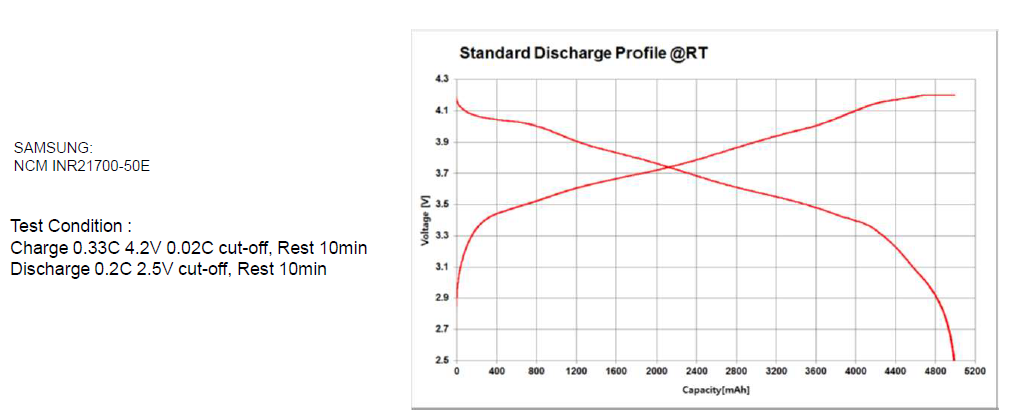
Lithium Battery – High and low temperature performance
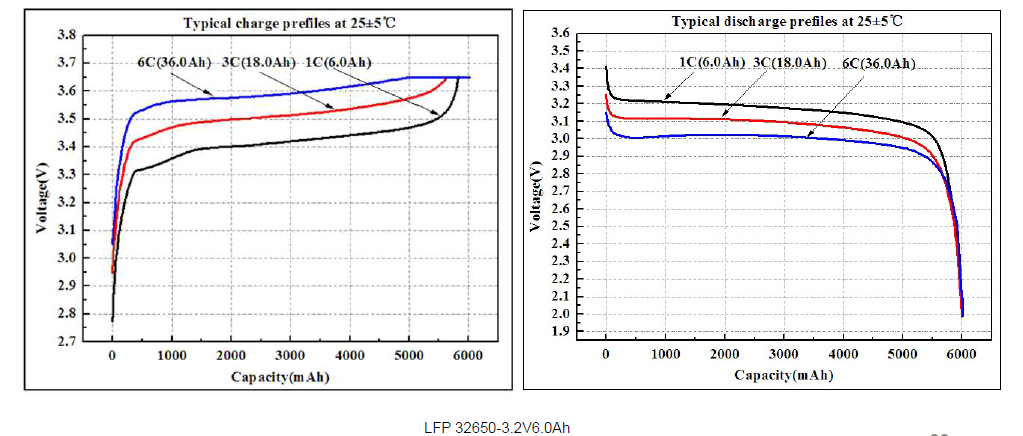
Lithium Battery – High and low temperature performance
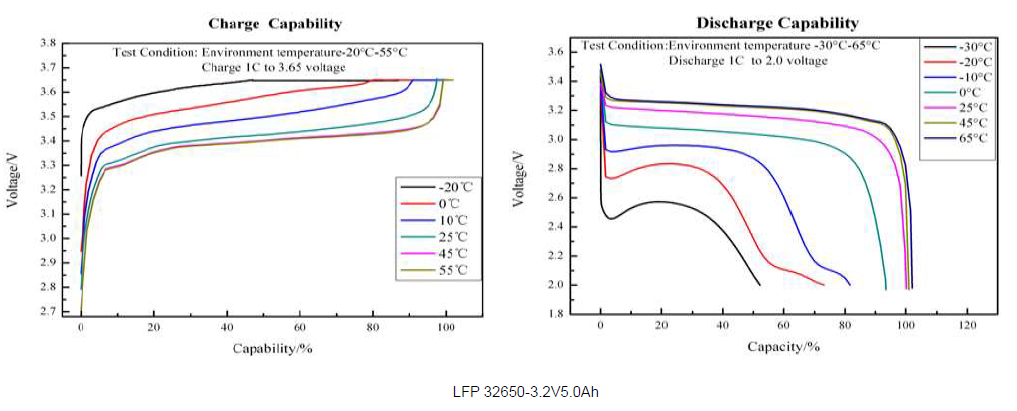
Lithium Battery – Cycle performance at different charging rates
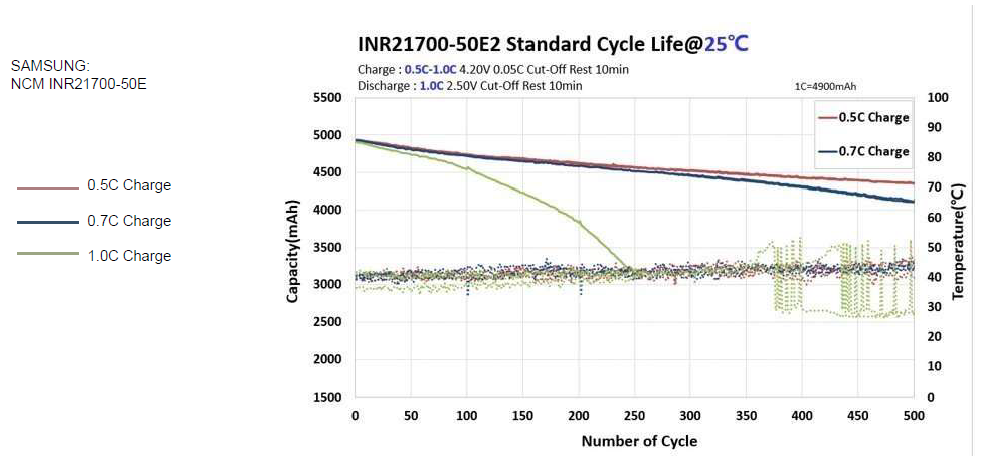
Lithium Battery – Cycle performance at different discharging rates
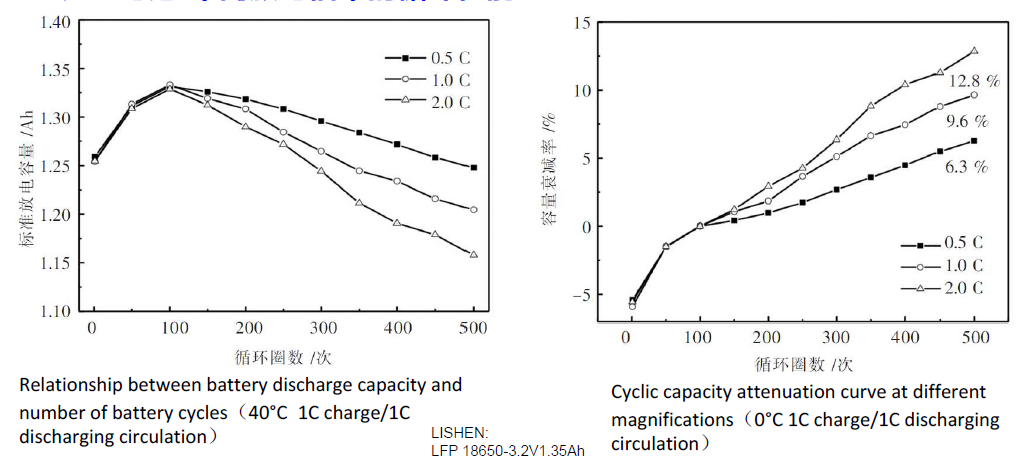
Lithium Battery – Effect of DOD on cycle life
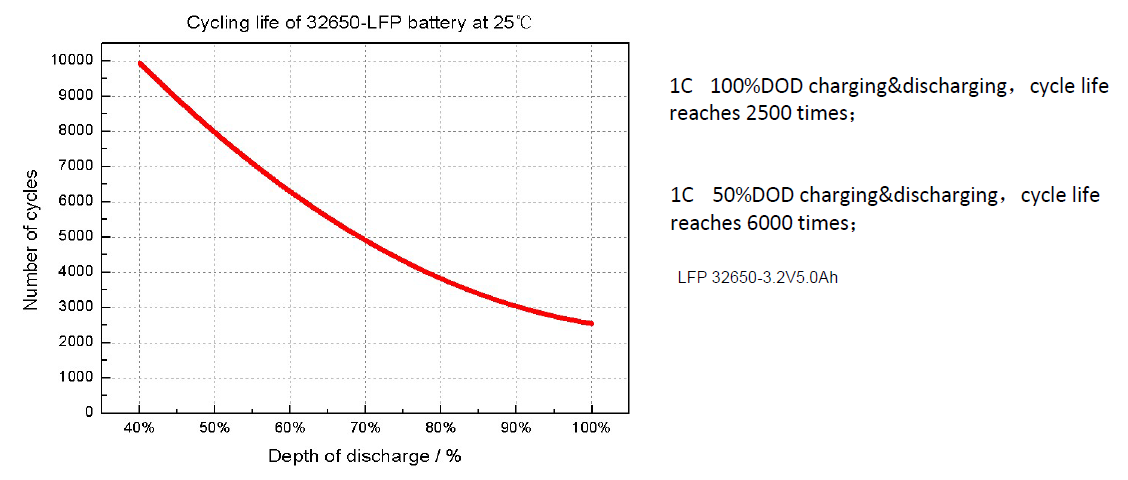
Lithium Battery – Effect of temperature on cycle life

Lithium Battery – Room temperature rate discharge, discharge efficiency, temperature rise
Room temperature rate discharge
1. Charge: constant current constant voltage, current 1.25A (0.5C), upper voltage 4.2V, cut-off current 0.05A (0.02C);
2. Set aside: 10min;
3. Discharge: with different sizes of current constant discharge, the lower limit voltage 2.75V;
4. Discharge efficiency = discharge capacity at each rate /0.5A (0.2C) discharge capacity;

|
0.2C capacity/Ah |
Discharge current |
0.5A |
1.25A |
2.5A |
5.0A |
7.5A |
10.0A |
|
Discharge rate |
0.2C |
0.5C |
1C |
2C |
3C |
4C |
|
|
2.573 |
Discharge capacity/Ah |
2.573 |
2.483 |
2.473 |
2.465 |
2.498 |
2.516 |
|
Discharge efficiency/% |
100.0% |
96.5% |
96.1% |
95.8% |
97.1% |
97.8% |
|
|
Maximum temperature/°C |
27.3 |
29.6 |
33.6 |
44.1 |
55.8 |
67.5 |
|
|
Temperature rise/°C |
0.9 |
3.5 |
7.3 |
17.8 |
29.5 |
41.1 |
Lithium Battery – Room temperature rate charge, charge efficiency, temperature rise
Room temperature rate charge
1. Discharge: current 0.52A (0.2C), constant current to 2.75V;
2. Set aside: 10min;
3. Charging: with different sizes of current constant current constant voltage charging, upper voltage 4.2V;
4. Charging efficiency = constant current charging capacity at each rate /2.5A (1C) discharge capacity;
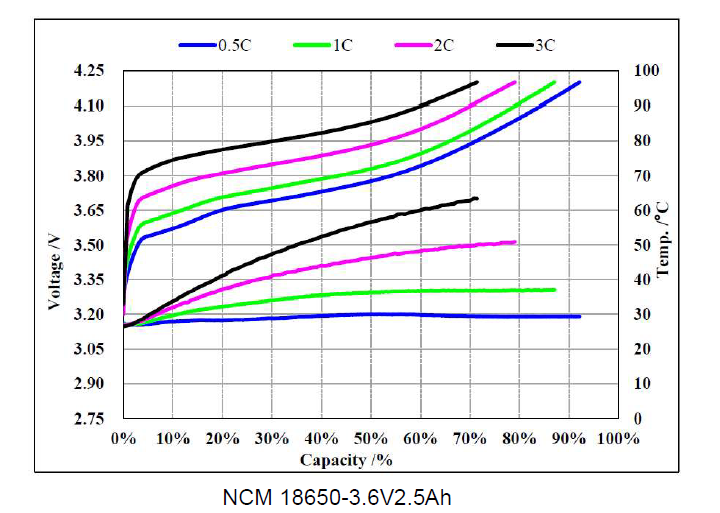
|
Initial capacity |
Discharge current |
1.25A |
2.5A |
5.0A |
7.5A |
|
Discharge rate |
0.5C |
1C |
2C |
3C |
|
|
2.481 |
Constant current charging capacity/Ah |
2.285 |
2.161 |
1.960 |
1.771 |
|
Constant current charging efficiency/% |
92.1% |
87.1% |
79.0% |
71.4% |
|
|
Maximum charging temperature |
29.9 |
37.1 |
50.9 |
63.4 |
|
|
Temperature rise/°C |
2.5 |
10.0 |
24.0 |
36.9 |
Lithium battery – Multiplier charge/discharge temperature rise principle
The heat generated by the charge and discharge process of lithium battery mainly consists of three parts
Form: heat of polarization, ohmic heat, heat of reaction, heat of reaction is endothermic reaction
Be responsible for;
The higher the charge and discharge ratio (current) is, the higher the internal resistance of polarization is, and the higher the heat production is.
Lithium Battery – Match battery PACK
“Eight consistent” match battery pack principles: consistent capacity, consistent internal resistance, consistent constant current ratio, consistent platform time, consistent self-discharge, consistent voltage, consistent carried charge, consistent cycle.
Material knowledge of cell
Material knowledge of cell – Positive electrode
Classification of positive electrode: lithium iron phosphate, Ternary NCM/NCA, lithium manganese, lithium cobalt oxides, Lithium ferromanganese phosphate.
Material knowledge of cell – Negative electrode
Classification of negative active substances: artificial graphite, natural graphite, mesocarbon microbeads, soft carbon, hard carbon, carbon fiber.
Material knowledge of cell – Conductive agent
The conductive agent is to ensure that the electrode has good charge-discharge performance. A certain amount of conductive material is usually added when the electrode plate making, so as to improve the charge-discharge efficiency of the electrode.
|
Type |
Grain size nm |
Electrical resistivityΩ·m |
Specific surface area m2/g |
Feature |
|
Super P |
40 |
≤0.01 |
62 |
Small grain of conductive carbon black, which can be used in both positive and negative electrodes, have no lithium storage function at all and only conduct electricity. |
|
KS-6 |
flake-like |
≤0.0001 |
21±3 |
Large grain graphite powder, feather shape, has lithium storage function. |
|
VGCF |
150 |
≤0.0001 |
13 |
High efficiency superconducting carbon black, branched chain, high purity, especially good conductivity for lithium batteries. |
|
CNTs |
7-15 |
≤0.0001 |
190-260 |
Form of conductive network, good conductive performance, good thermal conductivity to reduce the polarization of the battery, improve the high and low temperature performance of the battery, high dispersion requirements. |
|
GNs |
flake-like |
≤0.000001 |
5±0.5 |
Surface contact conductive agent, conductive performance is the best, the dispersion requirements are too high. |
Material knowledge of cell – Adhesion agent
| Type | PVDFPoly(vinylidene fluoride) | CMC Carboxymethyl Cellulose | SBRPolymerized Styrene Butadiene Rubber |
| Structure | 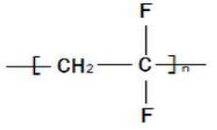 |
 |
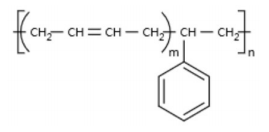 |
| Composition | White powder Vinylidene fluoride homopolymer | White powder Carboxymethyl substituent cellulose | White emulsion Butadiene and ABS |
| Function | Positive electrode adhesion agent | Thickening agent, settling agent, stabilizing agent | Negative electrode adhesion agent |
| Supplier | Solvay S.A./ARKEMA/KUREHA Group | Ashland/CPKelco/Dow/DAICEL | JSR/Zeon/Sojitz |
Material knowledge of cell – Foil
Current collector refers to the collection of current generated by the active substance of the battery to form a larger current output, which is in full contact with the active substance, small internal resistance, with good conductivity.
Aluminum foil – positive electrode potential is high, oxide film is very dense which can prevent current collector oxidation. The copper foil oxide film is looser, in order to prevent oxidation, low potential is better, and it is difficult for Li and Cu to form lithium-embedded alloy at low potential.
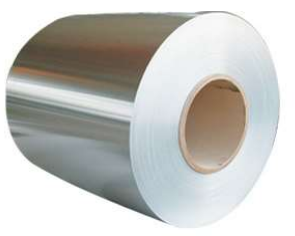
lithium-embedded
Copper foil-copper surface oxide film belongs to semiconductor, electron conduction, the oxide film is too thick, high resistance; AL will undergo LiAl alloying at the low potential of the negative electrode, which means that Al will be lithium-embedded at the negative electrode.
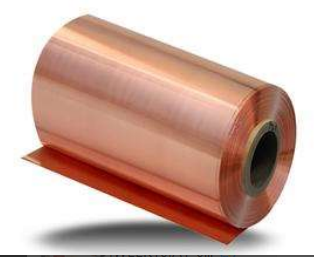
Material knowledge of cell – Lug
The lug is a metal conductor that leads from the positive and negative electrode of the battery. Generally speaking, the lugs of the positive and negative electrode of the battery are the contact points when charging and discharging.
| Project | Positive electrode lug | Negative electrode lug |
| Material | Aluminium strip | Nickel strip |
| Feature | Good electrical conductivity | Good electrical conductivity and corrosion resistance |
| Purity | ≥99.5% | ≥99.9% |
| Weldability | Easy to weld | Easy to weld |
Material knowledge of cell – Separator
Material: single layer PE (polyethylene) or three layers of composite PP(polypropylene) +PE+PP
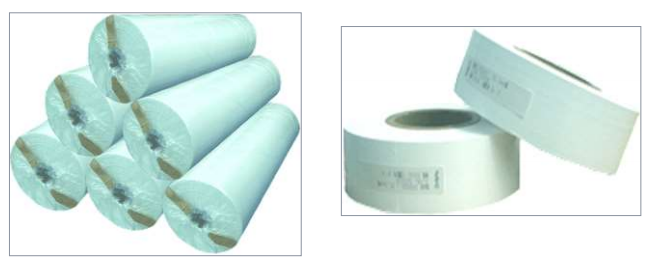
Function:
-
- Separate the positive and negative electrode of the battery to prevent short circuit;
- Adsorb battery electrolyte to ensure high ionic conductivity;
- Some also prevent the transfer of substances harmful to the battery reaction between the electrodes;
- Ensures that the battery reaction stops when an abnormal occurs, improving the safety performance of the battery.
Material knowledge of cell – Electrolyte
The electrolyte plays a role of conducting ions between the positive and negative electrodes of the battery, and is the bridge connecting the positive and negative electrode materials. Only operate in a dry environment (such as a glove box with moisture less than 20ppm).
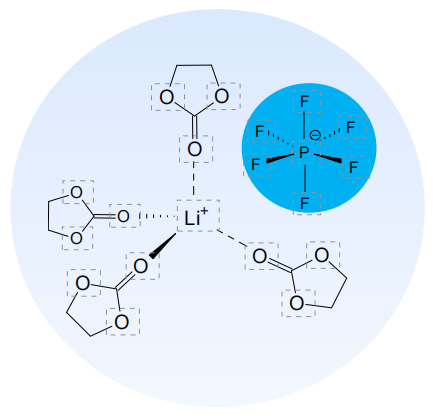
-
- Lithium salt: LiPF6
- Solvent: EC、DMC、EMC
- Additive: Film-forming agent、anti-overcharge、flame retardant、stabilizing agent etc.
Material knowledge of cell – Steel shell
The main function of the battery steel shell is to provide a good electrochemical environment.
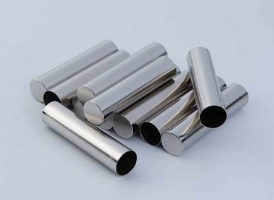
Performance characteristics of battery steel shell:
-
- Material processing performance is good, high precision, high strength;
- The surface hardness of the battery is high, and it has certain bearing property.
- Nickel plating: The battery has good corrosion resistance.
- The bottom generally cannot be laser spot welding.
Material knowledge of cell – Cap
The main function of the cap is to provide battery sealing function, provide the role of safety valve, to play the role of positive conductive terminal.
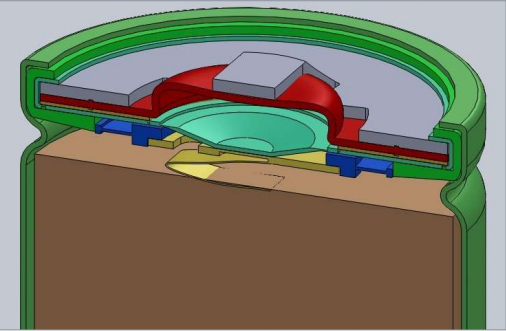
Technical requirements for cap:
-
- The material of the sealing ring is polyethylene propylene, 135℃ nondeformable;
- Smooth surface, uniform wall thickness, non-destructive appearance;
- The breaking pressure of cap is 1.2±0.1Mpa, and the opening pressure is 1.8±0.1Mpa;
- Small gasket does not deform and melt at 350℃ etc.;
- Caps are generally not soldering at high temperature.
Material knowledge of cell – Safety device
Some manufacturers’ cylindrical lithium iron phosphate battery built-in gas release vent and safety valve(CID) to improve its safety protection function, “double protection” effectively solves the safety problems caused by high temperature in extreme conditions such as overcharge, short circuit, collision, etc.
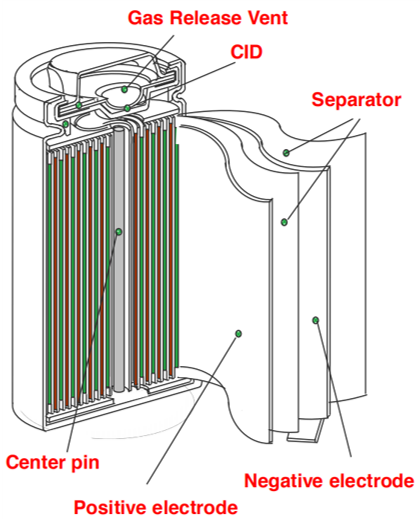
Gas release vent device: When chemical reactions occur in the battery, the gas generated in the battery accumulates in the gas release vent through the vent hole and upper and lower openings, which helps the gas in the battery to disperse, ensure the air-pressure balance in the battery cell, and avoid potential safety risks.
Safety valve(CID): When the internal pressure reaches 1.2±0.1Mpa, the positive lug and cap are disconnected, and the chemical reaction in the battery is suspended. When the internal pressure reaches 1.8±0.1Mpa, the safety valve will be opened and the gas discharged to avoid the risk of explosion.
Craft knowledge of cell
Craft knowledge of cell – Craft process
Below is the craft process of cell:
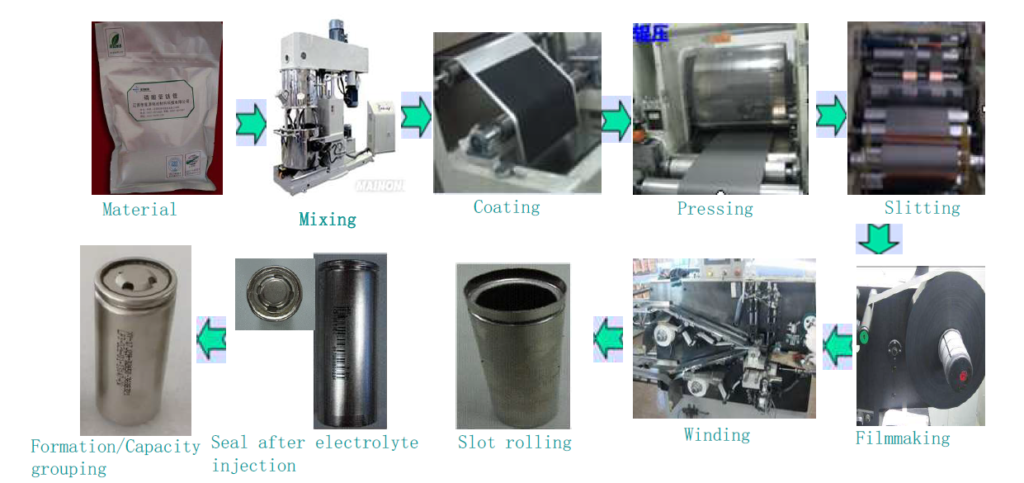
Structure knowledge of cell
Structure knowledge of cell
Below is mind map of structure knowledge:
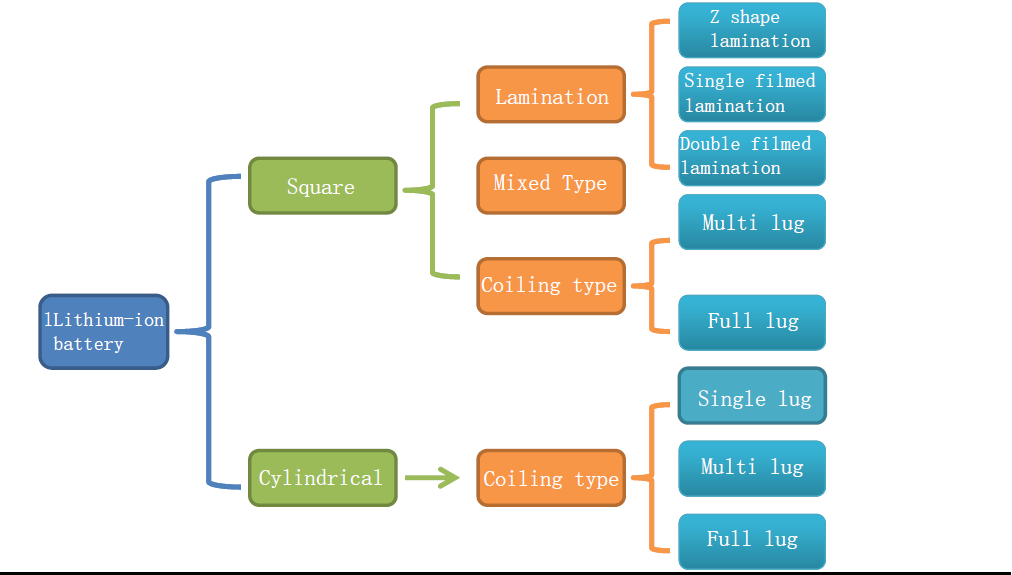
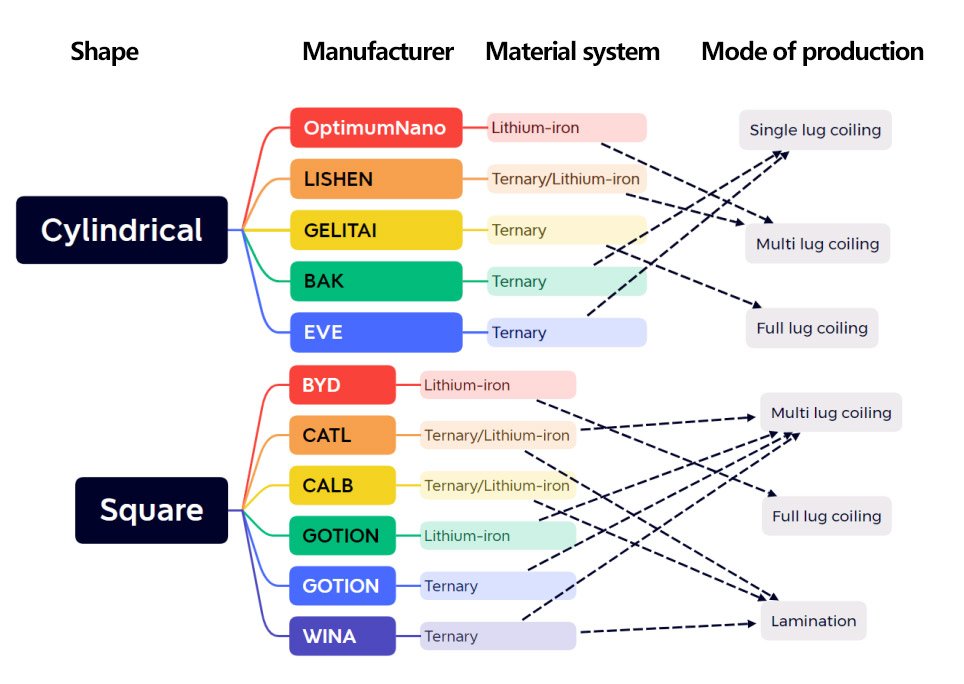
Structure knowledge of cell – Square lamination
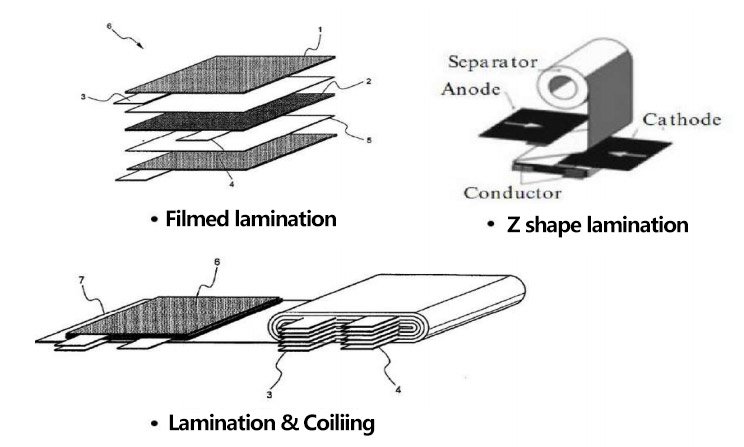
Structure knowledge of cell – Square Z shape lamination
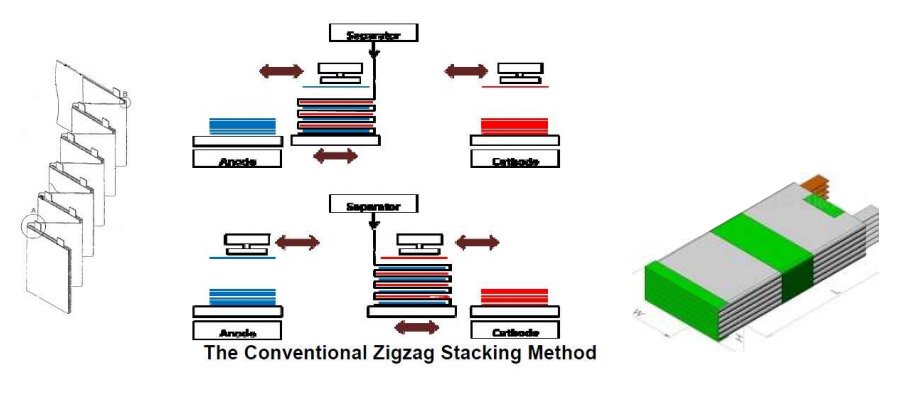
Structure knowledge of cell – Square filmed lamination
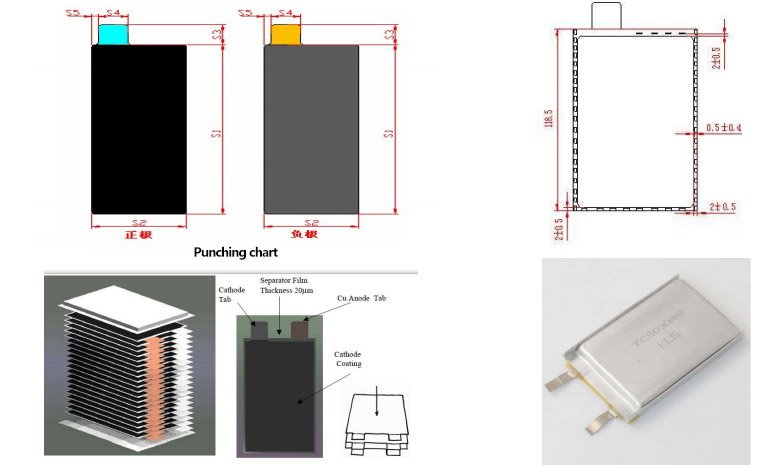
Structure knowledge of cell – Square multi lug coiling
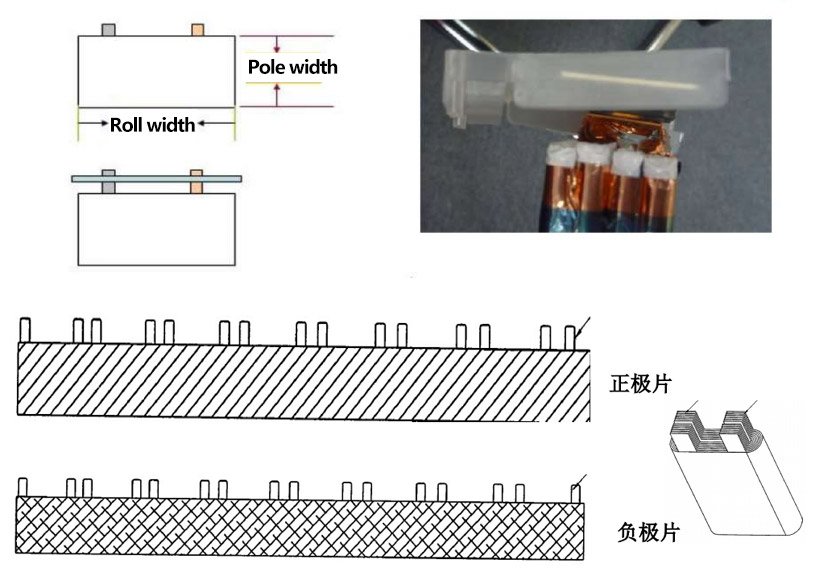
Structure knowledge of cell – Cylindrical single& multi lug coiling
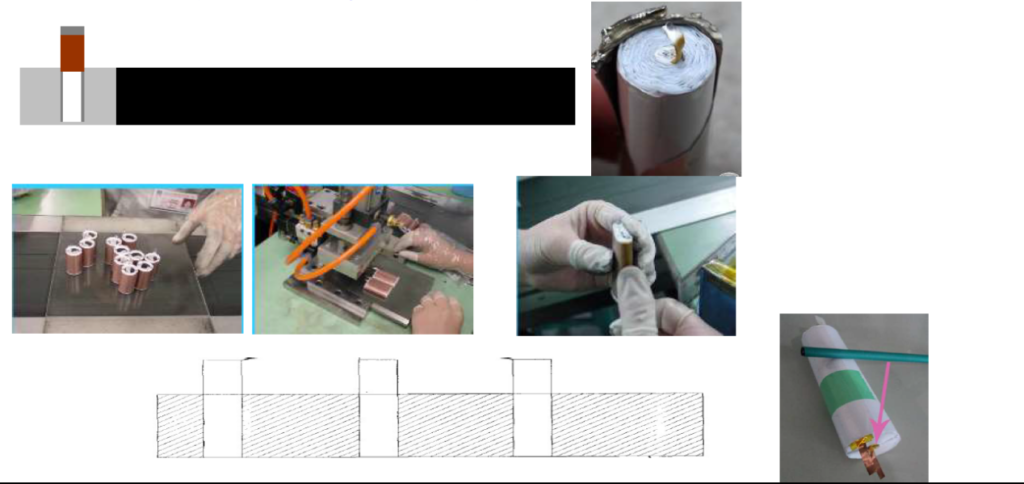
Structure knowledge of cell – Cylindrical full lug coiling
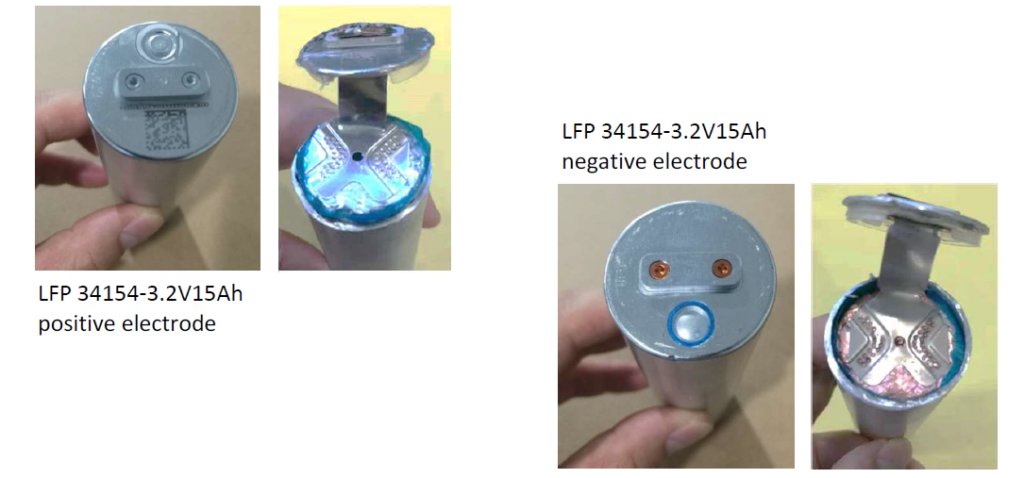
Structure knowledge of cell – Summary
| Cell structure | Methods of fabrication | Manufacturing characteristics |
| Z shape lamination | Manipulator positioning laminate | More edge, difficult to control burr, drop powder; Hard to bind tightly; Low efficiency; |
| Coiling lamination | Diaphragm winding, pole piece single piece | More edge, difficult to control burr, drop powder; Complex machine structure; It is difficult to control alignment accuracy and high efficiency. |
| Square coiling | Continuous winding | Less edge, easy to control burr, less powder, high manufacturing efficiency; Good consistency; Good mass flow design; But batteries are prone to deformation; |
| Cylindrical coiling | Continuous winding | Less edge, easy to control burr, less powder, high manufacturing efficiency; Good consistency; Uniformity of the effusion; Difficult to design mass flow. |
| Project | Coiling | Lamination |
| Internal resistance | Higher internal resistance because there are usually fewer lugs (except full lugs) | Low internal resistance. It is equivalent to multiple small lug plates in parallel, reducing the internal resistance |
| Rate | It is difficult to complete the discharge fully with a large current because of fewer lugs. | It is easier to complete large current discharge in a short time with multi lug plate parallel |
| Energy density | Monomer difference is not obvious | In general, lamination is superior and PACK convenient |
| Process control | The process is simple and easy to automate | The process is tedious, the rolled yield is low, and it is not easy to automate |
Summary:The advantage of roiling is that the process is easy to control, and the advantage of lamination is that the battery energy density is slightly higher and PACK convenient.
| Project | Multi lug | Full lug |
| Technological difficulty | The overall process of the craft is difficult:Whether use metal mold or laser cutting, can not avoid the production of a large number of dust and metal chips, is a great threat for the battery safety performance (square)Need to weld lug, low efficiency, lack of safety (cylinder) |
The overall process difficulty of the full lug craft is small: 1. The craft difficulty of coating, pressing, slitting, winding and other processes is less than multi lug craft; 2. High automation degree |
| Coiling | This structure will cause tension fluctuations during coiling, resulting in electrode core folding and other problems. | This structure will be beneficial to reduce the tension fluctuation during coiling and the coiling problem will be less |
| Space utilization | When the shell length/width is small, the relative utilization rate is higher | The longer the length, the higher the utilization rate |
| Rate performance | General rate | High-rate |
| Equipment investment | More | Less |
Summary:
Multi lug deficiency points more, especially a certain security risks; But when the capacity is small, it has the advantage of energy density.
The full lug project is better overall, especially in the capacity battery, the full lug project should be the first choice.
For more articles on lithium-ion cells:
21700 vs 18650 battery, battle on LEV
Which 18650 battery is best for an e-bike?
Tritek is a professional lithium battery power solution company founded in Shenzhen. Tritek offers a wide range of power solutions for LEV lithium-ion batteries for both commercial and domestic usage.
The experts at Tritek have 12 years experience in the design, R&D, and sales of LEV lithium-ion batteries. The lithium-ion batteries produced at Tritek are compliance with global certification standards for LEV batteries, such as EN15194:2017, UN38.3, CE, FCC, CB, UL, etc. Tritek has already set up customer service centers in Spain in 2022 and in Germany in 2023, also planning to set up in the United States to enhance the consumer experience.
You can get a customized lithium battery pack for your light electric vehicles,such as E-bike, E-motorcycle, Cargo-bike, etc.If you’d like to customized lithium battery for you LEV, feel free to CONTACT US.

